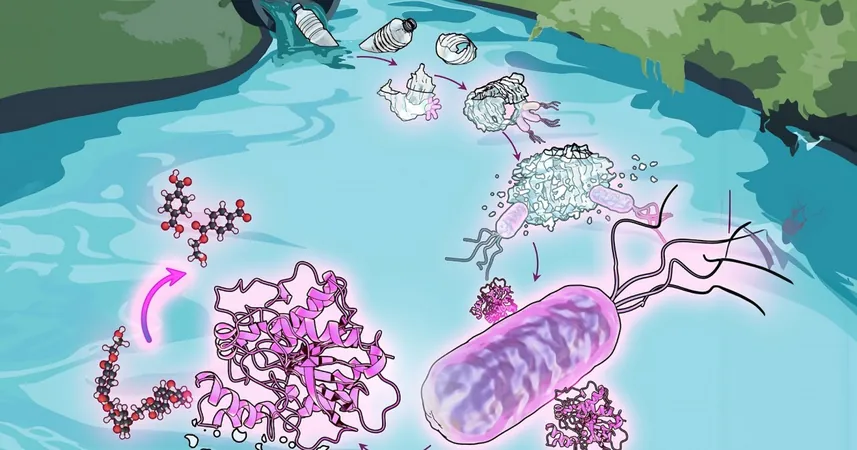
Groundbreaking Discovery: Wastewater Bacteria Can Devour Plastic for Food!
2024-10-03
Introduction
Researchers have uncovered a remarkable ability of a specific family of environmental bacteria known as Comamonadacae to metabolize plastic waste. Found in urban rivers and wastewater systems, these bacteria have typically been observed growing on plastic debris, but their actual role in breaking down these materials remained a mystery...until now!
The Discovery
A team led by Northwestern University has revealed that cells of a Comamonas bacterium are capable of decomposing plastic into nanoplastics and using them as a food source. Here’s how the process unfolds: the bacteria first chew up plastic into smaller fragments. Next, they unleash a specialized enzyme that breaks the plastic down even further, ultimately utilizing a ring of carbon atoms from the plastic as nourishment.
Significance of the Study
This groundbreaking study, published in the journal Environmental Science & Technology, highlights the incredible capacity of a wastewater bacterium to not only break down plastic—specifically polyethylene terephthalate (PET), a prevalent type of plastic used in food packaging and bottles—but also to transform it into a source of carbon essential for its survival. Ludmilla Aristilde, an associate professor of environmental engineering and the study's lead author, emphasized the significance, stating, “We have systematically shown that this entire process occurs, and we identified a key enzyme responsible for breaking down the plastic materials.”
Implications of the Research
The implications of this discovery are substantial, offering promising new avenues for developing bacteria-based technologies aimed at cleaning up stubborn plastic waste that contaminates drinking water and poses threats to wildlife.
Focus on PET Plastics
PET plastics are a critical target in this research. Representing about 12% of global plastic usage and contributing up to 50% of microplastics in wastewater, PET is notoriously difficult to degrade, leading to rising pollution levels. Aristilde’s previous studies have laid the groundwork by revealing how another bacterium, Comamonas testosteroni, metabolizes simple carbon compounds formed from broken-down plastics and plants.
Methodology
To investigate how C. testosteroni interacts with PET, the research team employed a blend of theoretical and experimental methods, including monitoring how the bacteria changed the surface of PET materials over time. Their findings showed that the presence of these bacteria resulted in the breakdown of microplastics into nanoparticles, underscoring their innate capacity to decompose plastics down to their basic building blocks—monomers.
Enzymatic Role in Degradation
A crucial element of this degradation capability is a specific enzyme identified through advanced "omics" techniques, which analyze the proteins and enzymes within the cells. Collaborators from the Oak Ridge National Laboratory assisted in further examining the enzyme's role by creating bacterial strains incapable of producing it. The results were astounding; without this enzyme, the bacteria's ability to break down plastic was severely compromised.
Future Questions
As illuminating as these findings are, they also raise further questions about the lifecycle of plastics in wastewater treatment systems. Aristilde notes, “Wastewater is a massive reservoir of microplastics and nanoplastics. Many assume nanoplastics enter treatment plants in that form, but our research indicates they can form in situ during wastewater treatment due to microbial activity.” This sheds light on the complex behavior of plastics throughout their journey from wastewater to natural waterways.
Conclusion
With this new knowledge, researchers are poised to explore innovative solutions to mitigate plastic pollution, drawing on the natural capabilities of bacteria to tackle one of the most pressing environmental challenges of our time. Can bacteria be the key to a cleaner, greener future? Only time will tell!

 Brasil (PT)
Brasil (PT)
 Canada (EN)
Canada (EN)
 Chile (ES)
Chile (ES)
 España (ES)
España (ES)
 France (FR)
France (FR)
 Hong Kong (EN)
Hong Kong (EN)
 Italia (IT)
Italia (IT)
 日本 (JA)
日本 (JA)
 Magyarország (HU)
Magyarország (HU)
 Norge (NO)
Norge (NO)
 Polska (PL)
Polska (PL)
 Schweiz (DE)
Schweiz (DE)
 Singapore (EN)
Singapore (EN)
 Sverige (SV)
Sverige (SV)
 Suomi (FI)
Suomi (FI)
 Türkiye (TR)
Türkiye (TR)